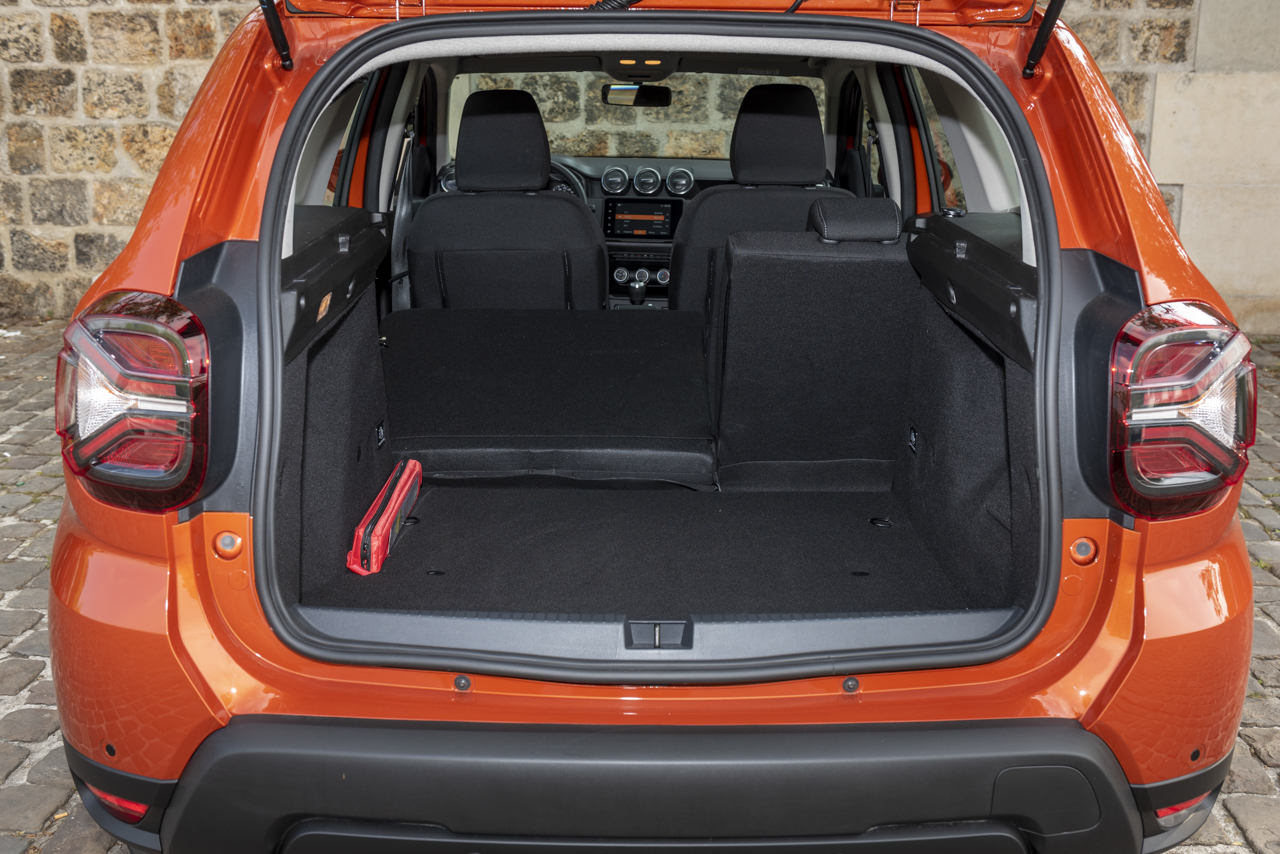
In its traction version, the second generation of the Suzuki S-Cross highlights its family ambitions and a good price/performance ratio among large urban SUVs. A credo shared by the Dacia Duster whose reduced prices could harm this new Japanese arrival.
Cars on test: Dacia Duster vs Suzuki SX4 S-Cross
| Dacia Duster 1.3 TCe 130 hp FAP Prestige 4×2 | |
|---|---|
|
€20,700 €330 bonus
|
| Suzuki SX4 S-Cross 1.4 Boosterjet Hybrid 129 hp Advantage | |
|
€27,090 no bonus |
The Suzuki S-Cross must live in the shadow of his little brother Vitara. Only 12 cm longer, financially less accessible and less assertive, it struggles to find a place in the sun. Despite identical underwear to its predecessor, which appeared in 2016, this second generation available since January 2022 changes its style to try to seduce. Its 4.30 m long make it one of the largest, but also one of the most welcoming urban SUVs in the segment. The all-wheel drive available on the posh finishes allows it off-road escapades prohibited to many rivals, but its traction version here on trial allows it to tighten its prices further.

The price precisely, remains as always the strong argument of a Dacia Duster which has occupied ninth place among the best-selling private vehicles in France since the start of 2022. Like its rival of the day, its dimensions almost halfway between the urban and compact format offer it real family aspirations. It can also receive all-wheel drive on the diesel, but not on its gasoline versions. Its 130 hp 1.2 TCE may not have the right to a 48 V hybridization like at Suzuki, but Dacia’s hitherto unbeatable price/performance ratio makes it particularly confident! Especially since its low-cost label does not prevent it from continuing to turn heads thanks to its inimitable face. So here is the S-Cross forced to pull out all the stops!
Price Suzuki S-Cross 1.4 Boosterjet Hybrid

The Suzuki S-Cross is available from €27,090 in the Avantage finish. It offers driving aids (line crossing alert, adaptive cruise control or emergency braking assistance), unavailable from Dacia. This remains very insufficient to align with a Duster Prestige sold €5,990 less and better equipped in absolute terms (see table). The top-of-the-range Style finish (pictured here) costs €30,690, an additional cost of €9,590 compared to its rival of the day. Suffice to say that the 48 V hybridization and the lower consumption of almost 1 l per 100 km struggle to justify the additional investment. The manufacturer’s discount of €3,300 on the entire S-Cross range up to 1er June does not allow him to catch up.
Dacia Duster TCE 130 price

Much more affordable than those of its rivals, the prices of the Duster TCe 130 start from €19,850 in the Comfort finish (pictured here). Given the price differences, the Prestige model billed at €21,100 is more justified here, even if the price difference of €5,990 in its favor (€2,690 with the Suzuki reduction) is still huge. Despite a penalty of €330, Dacia nipped the match in the bud. Given the importance of the savings made, the owner of a Duster TCe 130 Prestige has plenty of time to indulge himself with certain options: Western Europe GPS mapping (€100), heated front seats (€200 ) or multiview cameras (€300).
To drive
The dominant driving position of our two SUVs is particularly appreciated in town. The S-Cross benefits from a dashboard installed lower than that of its rival to improve forward visibility. Assisted by a light hybridization 48 V, the Japanese 1.4 turbo flaunts its qualities. The little boost (10 kW and 53 Nm) offered by the electric assistance does not allow it to drive in electric mode, but it provides incredible availability from idle speed. This incomparable flexibility saves a few gear changes and makes driving smoother. The stop & start system which cuts the engine just before stopping is more forgotten than the already very discreet one from Dacia, especially during restarts.

With its massive dashboard, its upholstery with a slightly rougher backrest, the Duster assumes a pinch of rusticity in an increasingly polished urban SUV landscape. It adds a little flavor of adventure to urban developments. This does not prevent it from doing well there, with an easy-to-handle size and lighter steering. The TCe 130 does not show itself there, on the other hand, not as comfortable. Its hollow character under 2,000 rpm and its inertia when accelerating can generate a few jerks when starting and changing gears. The Duster makes up for it with the exceptional absorption quality of its suspension. As accommodating on small urban bumps as its rival, it flies over speed bumps with much more ease. In addition, the 16-inch wheels of our test version appear less vulnerable to small daily aggressions than the 17-inch mounts of the S-Cross.
When it’s time to hit the road, the mechanics of our two urban SUVs are sufficiently invigorating. to keep up the pace with arms and baggage. Available and efficient, they take advantage of their six-speed gearboxes to lower fuel consumption and noise levels on the highway. The S-Cross deals with more pronounced bearing noise, while its rival suffers more aerodynamic whistling. Despite slightly superior performance on paper, the Japanese 1.4 seems a little less playful at high revs, but relies on its micro-hybridization to be even more sober than a 1.3 TCe already not particularly greedy. Except for a slightly more marked engine brake, this famous micro-hybidation works completely transparently.

Compared to the competition, the S-Cross and Duster favor comfort over dynamism. Suzuki, however, offers a more road type, with slightly less ample body movements. The Japanese is also a little more agile on winding roads, but also more precise. With its light and overly geared steering, the Romanian rival does not offer as much feeling and distills driving sensations more reminiscent of the 4×4 universe. His authoritarian ESP can also cut him in his tracks when pulling out of a tight bend. The Duster still retains a safe behavior and highlights its excellent damping to erase smashed coatings with incredible skill. Its all-road capabilities far superior to those of its rivals make it the most adventurous of urban SUVs. A good hearer!
To live
Despite a presentation that is still a little outdated compared to references of the genre such as the Peugeot 2008, the passenger compartment of the S-Cross bears witness to the efforts made by Suzuki. Although foamed plastics are still rare, the materials are quite correct and the atmosphere is much less sad than before. The other big improvement is at the interface level with a beautiful 9-inch touch screen on the high-end Style version, here in photos. The graphics are precise and the ergonomics, well thought out, even if the whole lacks a bit of responsiveness.


The atmosphere appears infinitely more rustic when boarding the Duster. The rough-hewn dashboard is not frills, even if the three round air vents that dominate the center console brighten up the presentation. The omnipresence of hard plastics partly explains the discounted prices of the Renault group’s Low Cost brand, but the assemblies are serious. The simple ergonomics make it easy to get started and the 8-inch touch screen means you don’t have to get lost in a multitude of menus and sub-menus to find your way around. The numerous USB ports in the front, as in the rear, and the smartphone replication make it sufficiently connected, unlike the outdated GPS interface.
S-Cross and Duster offer enough space on board to make it the main vehicle of a small family. Despite a comparable width at the elbows and sufficient to accommodate three people of average size in the back, the Japanese takes the advantage with a few good extra centimeters in terms of legroom. Its reclining backrests make them pleasant, except in the middle where the upholstery seems a little firmer than on board the Romanian. Dacia takes advantage in terms of practical aspects with larger storage.


With a volume of 430 l, the trunk of the Suzuki is rather generous, but its lower length does not allow it to take the upper hand against the 478 l of the Dacia. On the other hand, it is more usable on a daily basis thanks to a loading sill lowered by almost 10 cm and a removable double bottom which makes it possible to maintain a flat surface, once the rear seatbacks have been folded down. This is not the case of the Duster which composes with a step, once the bench folded.


Find the results of the Suzuki S-Cross vs Dacia Duster match, but also the technical sheets, prices, equipment and options compared on the following page.
















